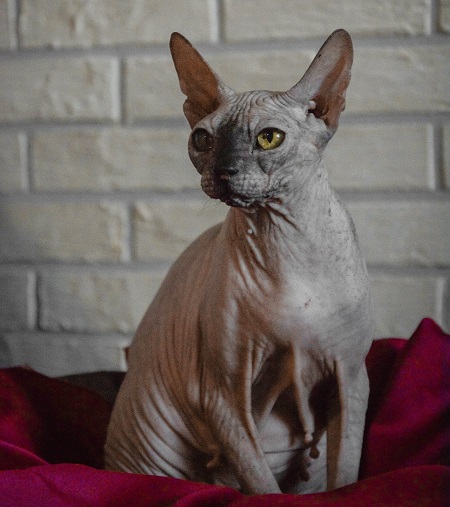
When one thinks of cats, images of fluffy fur and elegant tails often come to mind. However, there is one extraordinary breed that defies these expectations—the Sphynx cat. Known for its striking hairlessness and captivating appearance, the Sphynx has gained popularity among cat lovers around the world, particularly in the United States. In this article, we will explore the fascinating history of the Sphynx cat and unravel the reasons behind its rising fame in America.
Contrary to popular belief, the Sphynx cat is not entirely devoid of fur. It is covered in a thin layer of downy hair that gives it a unique velvety texture when touched. The breed’s origins can be traced back to the mid-1960s in Toronto, Canada, where a domestic cat named Elizabeth gave birth to a hairless kitten named Prune. This kitten possessed a natural genetic mutation that resulted in its hairlessness. Breeders recognized the potential of this distinct feature and began selectively breeding Sphynx cats to establish the breed.
The Sphynx cat’s road to popularity in America began in the 1970s when a pair of these remarkable felines made their way across the border. In 1975, the first Sphynx cat arrived in the United States, followed by several more imports over the next decade. These early pioneers of the breed were met with curiosity and intrigue, captivating cat enthusiasts with their unconventional appearance. The breed’s unique looks sparked interest not only among cat fanciers but also in the media. The Sphynx’s striking appearance attracted attention from journalists and photographers, who featured them in newspapers and magazines. These media appearances played a significant role in increasing the breed’s visibility and capturing the public’s imagination.
As the Sphynx’s popularity grew, dedicated breeders in America worked tirelessly to refine and develop the breed further. They focused not only on preserving the distinctive hairless trait but also on enhancing the breed’s overall health and temperament. Through careful breeding practices, they aimed to eliminate genetic health issues commonly associated with the breed.
One of the defining characteristics of the Sphynx cat is its affectionate and extroverted nature. These cats are known for being sociable, friendly, and eager to interact with their human companions. Their lively personalities and love for attention make them ideal pets for individuals and families seeking a devoted feline companion.
The rise of the internet and social media played a significant role in propelling the Sphynx cat’s popularity to new heights. Platforms like Instagram and Facebook allowed Sphynx cat owners to share captivating photos and heartwarming stories about their pets, captivating audiences worldwide. The striking visuals of the hairless cats, coupled with their endearing personalities, made them a hit among social media users. Sphynx cat accounts gained thousands of followers, making the breed even more visible and desirable.
In recent years, the Sphynx cat has become a favorite choice for many cat lovers in America. Their unique appearance, combined with their playful and affectionate nature, has made them a sought-after breed. However, it’s important to note that owning a Sphynx cat requires a special commitment. Due to their lack of fur, Sphynx cats need regular bathing to maintain skin health, protection from temperature extremes, and diligent ear cleaning to prevent wax buildup.
As the Sphynx cat continues to captivate cat enthusiasts around the world, it’s essential to remember that behind their hairless exterior lies a breed full of charm, personality, and love. Whether it’s their captivating looks, their playful antics, or their unwavering devotion to their human companions, the Sphynx cat has undoubtedly secured its place as a beloved and popular breed in America and beyond.
10 Fun Facts About Sphynx Cats
Not Actually Hairless
Contrary to popular belief, Sphynx cats are not completely hairless. They have a thin layer of downy hair that gives them a soft and velvety feel.
Warm to the Touch
Due to their lack of fur, Sphynx cats have higher body temperatures compared to other breeds. When you touch them, they often feel warm, which can be quite comforting.
Hypoallergenic
While they are not completely hypoallergenic, their lack of fur reduces the amount of dander they produce. This makes them a better option for some people with allergies compared to other cat breeds.
Energetic and Curious
Sphynx cats are known for their playful and active nature. They love to explore their surroundings and are always eager to engage in interactive play with their owners.
Attention Seekers
Sphynx cats thrive on human attention and affection. They are social creatures and enjoy being the center of attention. They will often follow their owners around the house and demand cuddles and pets.
Dress-Up Stars
With their unique appearance, Sphynx cats have become popular subjects for costumes and clothing. Some owners enjoy dressing them up in cute outfits to keep them warm or to create adorable photo opportunities.
Sun Worshippers
Despite their lack of fur, they enjoy basking in the sun. They are known to seek out warm spots in the house or soak up the sun’s rays near windows.
Peculiar Bathing Rituals
Sphynx cats require regular bathing to remove excess oils from their skin. Many of them enjoy the bathing process and will happily participate in the water-filled activities.
Prone to Sunburn
Due to the lack of fur, they are more susceptible to sunburn. It is essential to protect their skin from prolonged exposure to the sun by providing shade or using pet-safe sunscreen.
They Have Wrinkles
Sphynx cats often have loose, wrinkled skin, particularly around their face, neck, and body. These wrinkles add to their unique and charming appearance.
Related Articles & Free Email Newsletter Sign Up
Calico Cats Offer a Unique Coat Pattern and Can Bring Good Luck
Persian Cats Have Luxurious Fur and a Sweet Disposition


Comment here